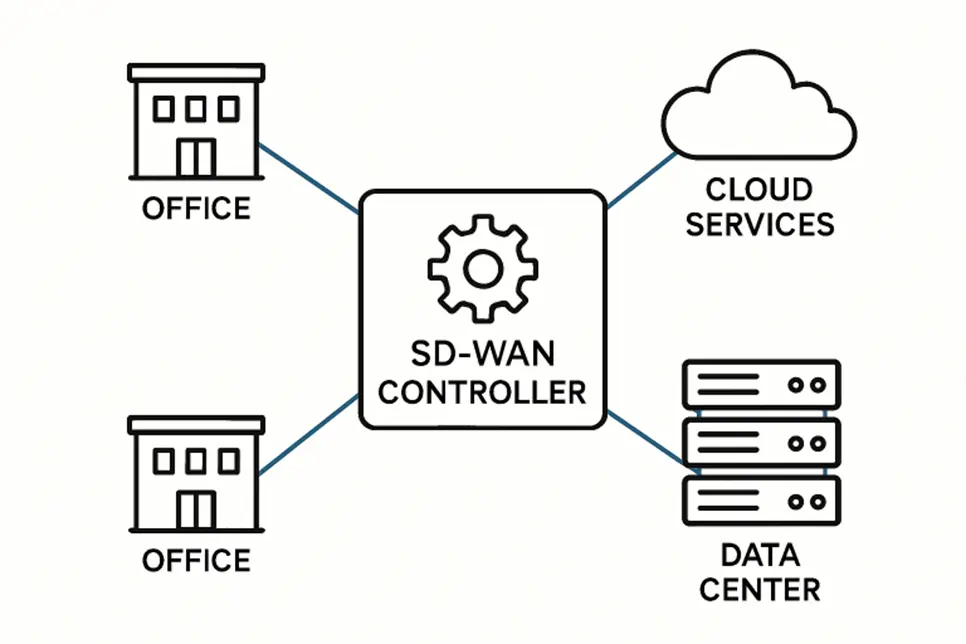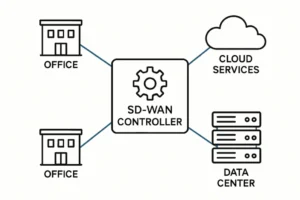Introduction
The shift towards digital-first business models has underscored the importance of resilient, agile, and cost-effective network infrastructures. Enterprises are embracing Software-Defined Wide Area Network (SD-WAN) solutions to address the high expectations for availability, security, and rapid adaptability across their organizational networks. Implementing a secure SD WAN helps businesses decrease complexity and support the rapid expansion required in today’s competitive environment.
SD-WAN solutions revolutionize how companies connect branches, data centers, and cloud resources, empowering IT teams with the flexibility to prioritize applications, enhance protection, and achieve performance gains without a massive capital outlay. This new paradigm is especially relevant as employees depend on distributed work environments and cloud-based services for daily operations.
Unlike traditional WAN architectures, which often rely on costly and rigid private connections such as MPLS, SD-WAN harnesses lower-cost connectivity options, streamlining setup and ongoing management. As network demands evolve, SD-WAN’s centralized management and automation features simplify what was once a daunting operational burden for large enterprises.
With businesses under constant pressure to innovate and maintain seamless user experiences, SD-WAN doesn’t just keep pace—it delivers measurable advances in agility, performance, and security while reducing costs. This has made it the backbone of modern enterprise network strategies, allowing organizations to expand globally without sacrificing reliability or control.
For a deeper understanding of how SD-WAN enables business transformation, explore related analysis from Gartner, exploring the real-world benefits and current trends driving secure networking adoption.
Network Agility
In today’s enterprise landscape, seamless network agility is essential. SD-WAN addresses this need by empowering IT teams to dynamically reroute traffic in response to congestion, outages, or shifting business priorities. As SD-WAN constantly evaluates link health and application requirements, business-critical applications automatically receive optimal bandwidth and minimal latency. This responsiveness enables organizations to support mergers, sudden branch rollouts, or seasonal spikes without painstaking manual intervention, ensuring business continuity and operational resiliency.
Cost Efficiency
One of the most compelling benefits of SD-WAN is its transformative impact on IT budgets. Organizations gain significant flexibility in controlling expenditures by leveraging affordable broadband, fiber, and LTE networks alongside—or even instead of—traditional MPLS. SD-WAN’s abstraction layer allows businesses to leverage multiple connection types, scaling infrastructure to fit present needs without locking themselves into expensive, long-term contracts. This cost agility positions enterprises to reinvest in innovation and new initiatives rather than escalating network spend—a shift supported by data from SDxCentral on digital transformation trends.
Performance Boost for Cloud Applications
The proliferation of SaaS platforms and cloud workloads has created heightened expectations for network performance and uptime. SD-WAN equips businesses to meet these demands by continuously optimizing the path data takes through the network, reducing latency for mission-critical and latency-sensitive applications. Dynamic traffic steering, quality of service (QoS), and direct cloud access improve overall user experience—making video conferencing, collaboration, and business applications more reliable and responsive, even in remote or bandwidth-constrained locations.
Simplified Network Management
Traditional WAN management has long been burdened by manual configurations, complex hardware dependencies, and time-consuming maintenance tasks—factors that often result in misconfigurations, security gaps, and costly network downtime. Software-Defined Wide Area Networking (SD-WAN) transforms this outdated approach through centralized, cloud-based orchestration. IT teams can seamlessly configure, monitor, and enforce network and security policies across all branch locations from one interface using a single-pane-of-glass management console. Updates and changes—once requiring days of coordination—can now be executed within minutes. This automation enhances operational efficiency and aligns IT with broader business agility goals. By reducing manual intervention and streamlining workflows, SD-WAN empowers organizations to allocate more time and resources to innovation, digital transformation, and long-term strategic growth.
Enhanced Security Features
As cyber threats become increasingly sophisticated and relentless, modern SD-WAN solutions have evolved to embed enterprise-grade security directly into their core architecture. Rather than relying on separate, disjointed systems, today’s SD-WAN platforms integrate advanced security features—such as next-generation firewalls, end-to-end encryption, unified threat management, and zero-trust segmentation—to safeguard data, applications, and users across distributed environments. This convergence of networking and security ensures consistent protection without compromising performance or agility. Organizations can maintain regulatory compliance, protect sensitive assets, and streamline IT operations by managing connectivity and defense from a single, cloud-based platform. As networks expand across branches, clouds, and remote users, SD-WAN delivers a holistic, adaptive approach that aligns security with evolving digital and operational demands.
Real-World Case Studies
Global organizations across diverse sectors have successfully deployed SD-WAN to address real business challenges. A prominent retail chain overhauled its network to unify hundreds of stores, slashing costs and dramatically enhancing voice and video call quality. A large-scale manufacturer enhanced visibility into supply chain operations, accelerating data-driven decisions and reducing downtime. One healthcare provider leveraged SD-WAN for secure, rapid expansion into new sites, protecting patient data while scaling to meet increased service demand. These case studies underline SD-WAN’s ability to elevate network performance and drive bottom-line results and future-proof business growth.
Conclusion
Software-Defined Wide Area Networking (SD-WAN) transforms enterprise connectivity by merging agility, cost efficiency, and intelligent control into a unified solution. Unlike traditional WAN architectures, SD-WAN dynamically routes traffic across multiple connections—such as broadband, LTE, or MPLS—based on real-time performance and application needs. This flexibility ensures optimal bandwidth utilization, faster cloud access, and consistent user experiences across distributed locations. Centralized management simplifies network configuration and monitoring, reducing operational complexity while strengthening overall visibility. Advanced security features like encryption, segmentation, and integrated firewalls protect data and applications. As organizations strive to balance scalability, performance, and protection, SD-WAN delivers the resilient digital foundation necessary for continuous innovation, hybrid workforce enablement, and sustainable global expansion in today’s increasingly cloud-driven business environment.
Also Read–Why Tech-Savvy Designers Are Turning to Virtual Tools for Better Results








